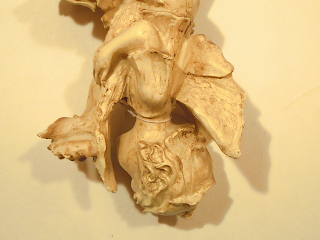I have a good friend who dislikes certain forms of popular art so much that he insists he's going to buy up every example he finds, simply to destroy them and take them off the market. While I'm not quite as passionate about ugly things, I decided to take my inspiration from him today, and remake something into an elephant.
Repurposing existing art has a long and illustrious tradition. Artists throughout history have painted over their own canvases—as well as the canvases of others—to produce something they like better. People have scavenged Classical architecture to make new buildings. Obelisks, stone circles and menhirs have been broken up for reuse. When my husband and I were in England a few years ago, we were shown around a massive Roman site that had been virtually razed to the ground by nearby villagers in the Middle Ages. They had made off with almost every stone on the site to build their own houses, walls and barns.
I happened across this garden figurine about a week ago, and right away saw an elephant in it. Normally I would overlook this kind of object, but I happened to catch sight of it upside-down, and decided that it was crying out to be remade into an elephant.
Once I got it home, I could actually see two elephants in it: one in the arms and wings of the fairy; another in the legs and large flower.
It seemed to be made of a dense resin, so I decided it would be best to try to cut into it with a rotary tool. I used both a grinding wheel and a thin carving bit.
I started by cutting off the figurine's head and base.
Next, I cut the figurine in half, careful not to slice off anything I might need later.
This left me with the rough elephant shapes below.
After this, it was mostly a matter of carving and shaping to arrive at the final elephants. This was an incredibly messy process, with a great deal of fine powder. I was smart enough to do this outside, but I should definitely have worn a dust mask.
The grinding blade was not the greatest for cutting, but it was great for shaping. The carving bit, however, was excellent for precision cuts, as long as I used it with an in-and-out motion like a reciprocating saw.
This is what they looked like when they were virtually finished.
While I was relatively happy with the shapes, I didn't like the way some of the underlying white resin was showing through. To smooth out the colouring a bit, I slathered on a blend of brown and black acrylic paint, then rubbed it off to give the final elephants a sort of antiqued driftwood look.
It took me about two hours to make both elephants, but it wasn't particularly difficult. The worst part was the nasty resin dust, but the carving and shaping was easy.
Both of these only look good from one side, but I was pleased at how well they turned out. They're abstract to be sure, but I don't think it's a bad transformation for a two-dollar garden fairy.
Elephant Lore of the Day
Elephants, like primates, may be intelligent enough to practice deception.
Several years ago, animal researcher Maxine Morris noticed an unusual pattern of behaviour among Asian elephants at Washington Park Zoo in Indiana. At feeding time, each elephant received a large bundle of hay. Morris noticed, however, that some of the elephants gobbled their hay quickly, then sidled over to the slower-eating elephants.
Swinging their trunks innocently from side to side, the more gluttonous elephants would suddenly reach out and snatch a bunch of their companion's hay, eating it quickly before the theft could be detected.
Swinging their trunks innocently from side to side, the more gluttonous elephants would suddenly reach out and snatch a bunch of their companion's hay, eating it quickly before the theft could be detected.
Opinion is divided on whether this is intentionally sneaky behaviour, or happy chance. Some researchers suggest that the elephants just got lucky, swinging their trunks around and accidentally snagging extra rations. The argument goes that the elephants simply kept repeating the behaviour on the off chance that some more hay might materialize at the ends of their trunks.
Whether or not the behaviour was intentional, elephants at other facilities sometimes suffered the consequences. While elephants are notoriously near-sighted and often didn't see the theft as it occurred, in some places, the victims became angry and aggressive towards the thief.
 |
| Tusko, an Asian elephant at the Oregon Zoo, enjoying some hay, 2009. Photo: Brock Parker Source: http://www.oregonzoo.org/gallery/category/elephants?type=All&items_ per_page=12&page=6 |
To Support Elephant Welfare
Elephant sanctuaries
(this Wikipedia list allows you to click through to information
on a number of sanctuaries around the world)

















this is one of my favorites
ReplyDeleteThanks, Mike!
ReplyDelete